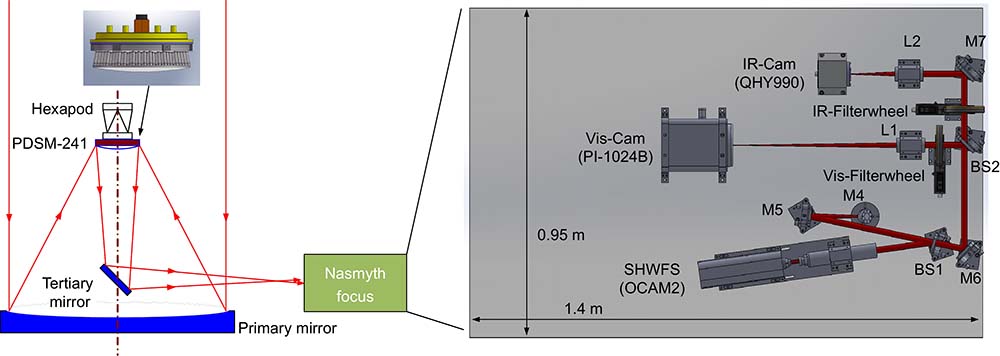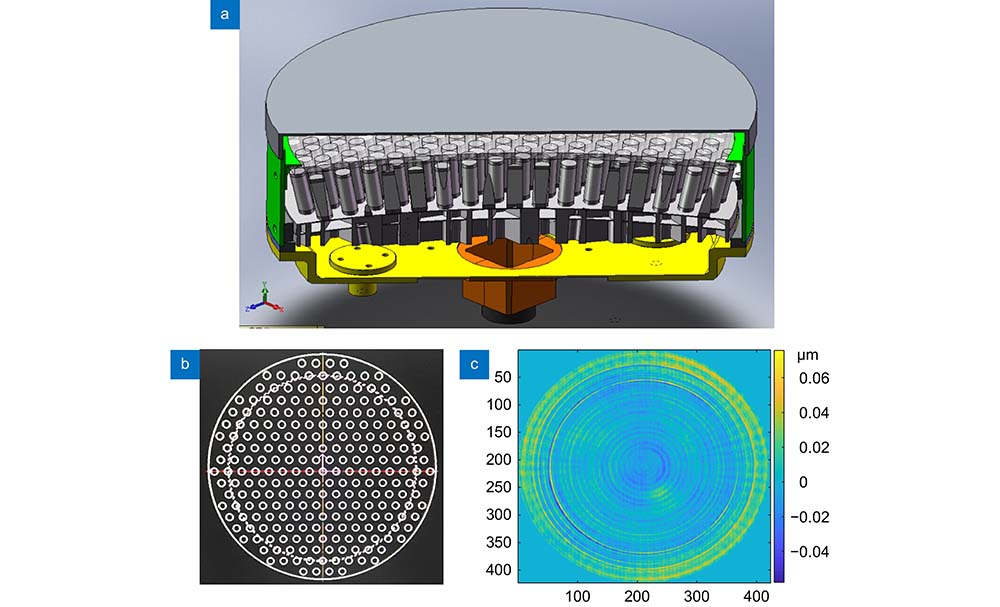Youming Guo, Kele Chen, Jiahui Zhou, Zhengdai Li, Wenyu Han, Xuejun Rao, Hua Bao, Jinsheng Yang, Xinlong Fan, Changhui Rao. High-resolution visible imaging with piezoelectric deformable secondary mirror: experimental results at the 1.8-m adaptive telescope[J]. Opto-Electronic Advances, 2023, 6(12): 230039
Search by keywords or author
- Opto-Electronic Advances
- Vol. 6, Issue 12, 230039 (2023)

Fig. 1. The sketch of the 1.8-m adaptive telescope.

Fig. 2. (a ) The sketch of the PDSM-241. (b ) Actuator layout (clear aperture: 270 mm). (c ) The uncompensated aberration of PDSM-241.
Fig. 3. The sub-aperture layout of the SHWFS (effective diameter: 16 mm) and the image of a collimated wave.
Fig. 4. Control strategy of the AOS.
Fig. 5. (a ) Flowchart of calibration of the interaction matrix. (b ) Closed-loop wavefront control.
Fig. 6. Temporal high order RMS error with AO system on and off at the time (UT) 14:00 on April 28, 2022. (HIP–49669, altitude angle: 71 degrees, azimuth: 217 degrees).
Fig. 7. Residual wavefront error distribution at the time (UT) between 13:30 and 16:15 on April 28, 2022.
Fig. 8. Closed-loop wavefront noise error distribution at the time (UT) between. 13:30 and 16:15 on April 28, 2022.
Fig. 9. Image motion comparison with the AO system on and off. x-tilt: Open-loop: 0.4", Closed-loop: 0.015" (left panel); y-tilt: Open-loop: 0.21", Closed-loop: 0.017" (right panel)
Fig. 10. PSD of tracking error in open-loop and closed-loop with the AO system on and off. x-tilt (left panel) and y-tilt (right panel).
Fig. 11. PSD of AO system in open-loop and closed-loop (left panel), error transfer function (right panel).
Fig. 12. Comparison of the Zernike RMS error in open-loop (circle) and closed-loop (square). The solid curve is the fitting of the Kolmogorov turbulence model to the open-loop data.
Fig. 13. The distribution of r0 at the time (UT) between 13:51 and 14:08 on April 28, 2022.
Fig. 14. The visible short exposure images of the star HIP49669 (2022-04-28), the images are displayed in linear scale and the peaks are normalized to 1. (a ) R-band, SR=0.491, FWHM = 0.0937”. (b ) R-band, SR=0.481, FWHM = 0.0953”. (c ) I-band, SR=0.574, FWHM=0.113”. (d ) I-band, SR = 0.582, FWHM=0.111”.
Fig. 15. Comparison of I-band closed-loop (left) and open-loop (right) image of the star HIP63418 (V-magnitude: 8.16).
Fig. 16. R band (~640 nm) closed-loop Strehl ratios with guide stars of different magnitudes.
Fig. 17. I band (~860 nm) closed-loop Strehl ratios with guide stars of different magnitudes.
|
Table 0. Main parameters of the Imaging cameras.
|
Table 0. Main parameters of the SHWFS.
|
Table 0. Details about the PDSM-241.
|
Table 0. The performance of the adaptive telescope with different magnitudes.

Set citation alerts for the article
Please enter your email address



